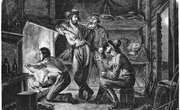Figurative language is any word usage that is not literal, and almost everyone speaks more figuratively than literally -- a friend is a "homie" even if he doesn't live at home; one stands solid and is still "trippin'." Figurative language intensifies meaning; that's why everyone uses it. It's not surprising, then, that early American literature, such as Washington Irving's "Legend of Sleepy Hollow," (reference 1, 1926) is filled with figurative usages -- metaphors, similes and personification -- all of which intensify meaning and the narrative line.
Metaphor and Simile
The first metaphor appears at once in Irving's tale: the setting is "Tarry Town," ironically referring to the lazy men who "linger about the village tavern." (reference 1, page 33). Into this slovenly atmosphere rides the protagonist, Ichabod Crane, and Irving plunges into an ecstasy of metaphor and simile describing him -- "hands that dangled a mile out of his sleeves . . . feet that might have served for shovels . . . his head . . . looked like a weathercock perched on his shoulders." (page 36). Further simile/metaphors vividly enhance Crane's eating habits, both in food -- he "had the dilating powers of an anaconda" -- and in believing supernatural stories -- "no tale was too gross or monstrous for his capacious swallow." (page 41).
Personifications
Irving intensifies his figuratives as he intensifies his story, adding personification to the mix. Ichabod's pleasure in telling stories by the fireside is "dearly purchased by the terrors of his subsequent walk homewards" (page 42); his safety becomes a living companion who deserts him in the dark. Katrina van Tassel, his intended, becomes a "tasty morsel" to him (page 45) -- more eating imagery. As he imagines his marriage to her, "the conquest of his heart was complete." (page 46) And his rival, Brom Bones, is described as "umpire of all disputes," whom others "felt no inclination to cross, a lion with his amours." (page 50).
Headless Figuratives
There is an explosion of figurative usages at the climax of the tale when Irving relates the chase of the Headless Horseman, who is called "the shadowy object of alarm" (page 68) and a "ghostly competitor" (page 70). The rider moves "like a whirlwind" (page 71) and becomes a "goblin rising in his stirrups"; his pumpkin head, thrown at Ichabod, becomes "a horrible missile." Ichabod disappears, and the road he last traveled becomes "an object of superstitious awe." (page 73).
Why Figuratives Work
Irving uses figurative language to intensify a number of elements of his classic tale, including character-based imagery, narrative action and thematic unity. He also uses figurative language for the same reason everyone else uses it: to express something beyond ordinary words or understanding, to add emotional context to language and to increase the enjoyment of its everyday use. He takes the literal away from its concrete nature and gives it to figurative imagination.
Related Articles
References
- Riverside Literature series: "Legend of Sleepy Hollow"
Writer Bio
Michael Stratford is a National Board-certified and Single Subject Credentialed teacher with a Master of Science in educational rehabilitation (University of Montana, 1995). He has taught English at the 6-12 level for more than 20 years. He has written extensively in literary criticism, student writing syllabi and numerous classroom educational paradigms.











